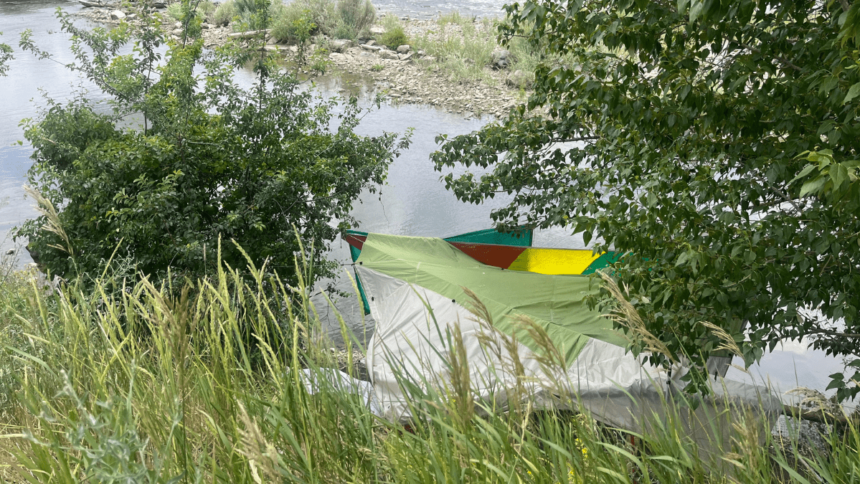Nearly a year after declaring a state of emergency regarding homelessness and months of grappling with next steps, the Missoula City Council this week approved controversial rules restricting camping on city property.
The rules, which take effect July 25, limit where and when people can camp on city property, including parks and streets.
Supporters said the restrictions are needed to mitigate the negative health, safety and environmental effects of unsheltered people camping on public property. Several council members emphasized the rules are not the city’s only response to homelessness and said the administration is working to provide support, such as additional bathrooms, safe parking and designated camping spaces.
Service providers and dozens of community members voiced concerns that restricting where unhoused people can go before providing stable alternatives will make it more difficult for the vulnerable population.
At the end of a nearly nine-hour meeting Monday night, the rules passed on a 10-2 vote, with council members Daniel Carlino and Kristen Jordan opposed. Carlino and Jordan said the restrictions will cause more problems for unsheltered people and go against the recommendations of service providers.
“We need authorized campsites we’ve all talked about and all those resources before we start moving people around in circles,” Carlino said. “Ordinances like this are going to keep people homeless longer in our community and not even solve the problem you all are going for.”
Council members supporting the regulations said they are an improvement from Missoula’s previous law banning all camping on city property. The city has not enforced the rule in recent years, in part because of the 9th U.S. Circuit Court of Appeals ruling that cities can’t criminalize homelessness if there is not adequate shelter available.
On Friday, the U.S. Supreme Court overturned the 9th Circuit Court’s ruling, clearing the way for cities to enforce outdoor sleeping bans, the Associated Press reported.
Mayor Andrea Davis called the new rules a “phase one” the city would evaluate and change as needed.
“No one city has mastered this. We are attempting to manage this the best we can with compassion and accountability,” Davis said Monday. “We are committed to trying things that help mitigate the impacts for survival camping in town, re-evaluate those initiatives, and we correct and continue.”
The new law sets buffer zones where people are not allowed to camp, including within 100 feet of a residential dwelling, public entrance…
“No one city has mastered this. We are attempting to manage this the best we can with compassion and accountability.”
Andrea Davis, Missoula mayor
Where camping is allowed, tents must be taken down from 8 a.m. to 8 p.m. each day.
The new law establishes a vehicle camping permit system allowing someone living in their vehicle to stay parked in certain areas for up to 90 days before moving to a different street.
Under the new rules, city officials must refer individuals to a shelter or other temporary housing and provide information about services before taking enforcement or abatement actions. A first violation gets a written warning with suggested remedies. Subsequent violations may be enforced as a municipal infraction, which is not a criminal charge.
State law allows municipal infraction fines up to $300, and the city would likely create a matrix increasing the fine for repeat violations, City Attorney Ryan Sudbury said during Monday’s meeting. Bozeman, which passed regulations limiting camping last November, fines $25 for a violation. Missoula city staff will aim to connect those violating the rules to resources or help them comply rather than charge a fine, Sudbury said.
“It’s certainly my hope that through a robust education outreach program that we don’t have many of these to deal with,” he said. “I don’t anticipate spending a lot of city attorney time chasing people down for small fines.”
City staff are working on a map that outlines where unhoused individuals can camp, along with the location of shelters and other resources, said Donna Gaukler, Parks and Recreation director. Along with the challenge of mapping each buffer, the department is considering locations for additional bathrooms, trash cans and syringe disposals with maintenance access, she said.
The law directs the mayor to develop a support program for unsheltered Missoulians, including providing lockers or small storage spaces, trash collection, bathrooms and other resources. It also calls for the mayor to investigate creating designated camping and parking sites on city or private property.
The city and Missoula County ran an authorized camping site on Reserve Street for about 11 months in 2022 before shutting it down due to budget constraints and difficulty managing the space with limited staff and resources.
During Monday’s meeting, Davis said providing a designated camping space is more difficult than she thought it would be while campaigning last fall. Along with planning for more bathrooms and trash cans, the city is meeting with prospective partners to consider safe parking locations and additional syringe disposals, Davis said.
“There is an enormous amount of administrative requirement to do what I’m talking about,” she said. “The reality is we still need to make these parks available for all the people utilizing these parks for their intended use as well, so we’re developing a program we hope will do both. I’m suggesting this is more or less a phase one as we figure out where there may be safe camping available for folks.”
The council amended the regulations to require an annual review, with the first potentially in January 2025.
Missoula has grappled with a spike in its unhoused population since the COVID-19 pandemic dramatically increased the cost of living.
On a single day in April, 622 households were experiencing homelessness in Missoula, according to the statewide database used by the city. Roughly 30 to 40% of Missoula’s homeless population is unsheltered.
Last June, the Missoula City Council approved an emergency declaration and a 90-day ordinance closing city-owned parks and trails, but not all city-owned land, from 11 p.m. to 5 a.m. In the following months, the council discussed making the rule permanent and considered regulations that would have prohibited overnight camping in all city public parks, trails and conservation lands. The proposal was criticized because it didn’t outline anywhere else for people to go, and it was tabled by the council.
Parks Director Gaukler told the council on Monday the city hasn’t been enforcing its camping ban but does ask people to move for obstruction of trails, damage to the area or an unsafe situation. Staff post a notice six days ahead of cleanup, she said.
The new law stems from recommendations from the Urban Camping Working Group, spearheaded by Davis after she took office. The group, which included Davis, all 12 city council members, business representatives and service providers, met five times from February through May. Ten of the 24 group members signed a report requesting the city designate safe camping and parking sites and provide basic services prior to enforcement or regulatory actions.
Seven executive directors of organizations, including the Poverello Center and Missoula YWCA, outlined similar concerns, particularly about the 8 a.m. to 8 p.m. camping ban, in a letter sent to the council ahead of Monday’s meeting.
“This stipulation will be detrimental to individuals striving for stability,” the letter said. “It hinders their ability to apply for jobs or maintain employment, attend necessary medical appointments and even access basic amenities.”
The rule will also make it more difficult for outreach teams to consistently support individuals forced to move during the day, the letter said.
About 50 members of the public spoke during Monday night’s meeting, with most opposed to the rules.
Many others voiced concerns that the buffers would confuse people and provide limited areas for them to go and called for the removal of the 8 a.m. to 8 p.m. restriction. Several people urged the council to listen to the concerns of service providers and people with experience of being homeless.
“Unsheltered people often sleep during the day because it’s safer. Where are they supposed to go from 8 a.m. to 8 p.m.?” said John Rhoades, Missoula community organizer for Montana Women Vote. “Pushing folks around the city and away from medical providers will increase visits to emergency rooms and into the criminal legal system. This will be expensive for the government and taxpayers.”
People camping in parks asked to take down tents at 8 a.m. will not be asked to leave, Davis said. It’s not forbidden to sleep or lie down in the parks, but tent camping is not allowed from 8 a.m. to 8 p.m., she said.
“Pushing folks around the city and away from medical providers will increase visits to emergency rooms and into the criminal legal system. This will be expensive for the government and taxpayers.”
John Rhoades, Missoula community organizer for Montana Women Vote
Council member Amber Sherrill said while shelters don’t work for everyone, they have open beds that need to be used.
As of March, Missoula had 513 emergency shelter beds at the Poverello Center, Johnson Street shelter, Hope Rescue Mission and YWCA’s shelters for families and domestic violence survivors, according to the 2024 Needs and Gaps Analysis by the Missoula Continuum of Care Coalition. The shelters, plus up to 12 transitional housing beds for families and 28 for veterans, are not enough to meet the community’s needs in capacity and in the variety of options.
Right now, the Poverello Center could fit, on average, 25 more people and Johnson Street could fit another 50, Poverello Center Executive Director Jill Bonny told Montana Free Press. The organization’s Homeless Outreach Team estimates about 150 people are living unsheltered, more than could fit in the two shelters, she said.
Unhoused people aren’t in the shelters for many reasons, more so in warmer months, Bonny said. Some are not allowed in either shelter for behavior reasons, and others don’t like the shelter rules or want to stay close to their partner, she said.
Bonny said she hopes more people come to the shelters if they are struggling to work around the new rules but worries people will move out of the city away from services and into areas with wildfire risk.
Enforcing a no-camping buffer zone without offering … 12 hours of the day,” Quattrocchi said. “It’s all jeopardized.”
In-depth, independent reporting on the stories impacting your community from reporters who know your town.





